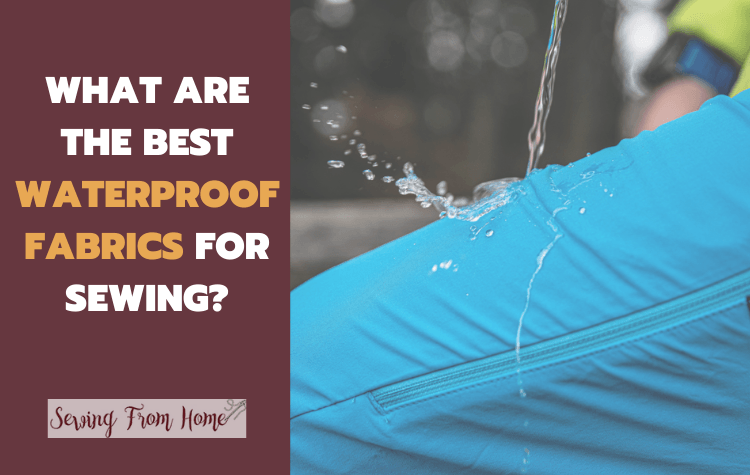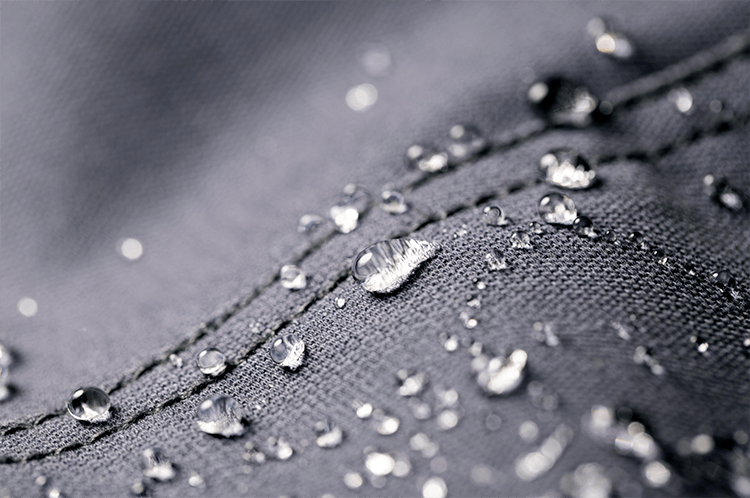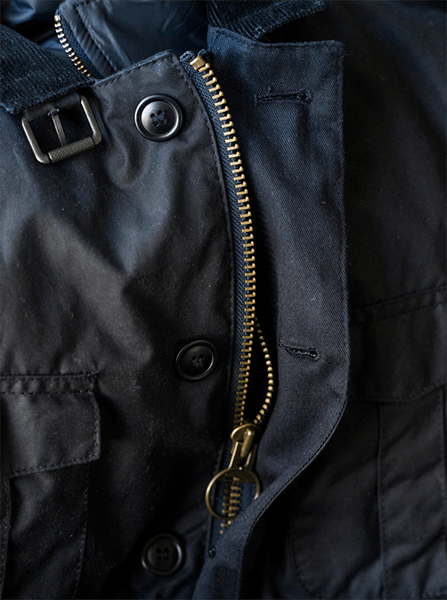Waterproof fabrics are a lifesaver – they keep you dry outdoors, protect babies from nappy rash, and prevent soggy towels from leaking into bags. But how do you know which waterproof fabric to use for different projects? What are the best waterproof fabrics for sewing?
The best waterproof fabrics are synthetics coated with a laminate or membrane, like Gore-Tex, PUL, TPU, vinyl, oilcloth, and Procare. Water-resistant and water-repellent fabrics are ripstop, nylon taffeta, microfiber, laminated cotton, ELS cotton, wool, and waxed cotton.
Sewing with waterproof fabrics can be very rewarding, as the household items and clothes you make are practical and functional. You can sew anything from raincoats to shower curtains, choosing the ideal fabric depending on how waterproof you need it to be.
Let’s look at the top 14 waterproof and water-resistant fabrics.
- What Are Waterproof Fabrics?
- What Are Water Resistant Fabrics?
- What Are Water Repellant Fabrics?
- What Are The Best Waterproof Fabrics?
- Gore-Tex
- PUL (Polyurethane Laminate)
- Sandwich PUL
- TPU (Thermoplastic polyurethane)
- Vinyl Or PVC
- Oilcloth
- ProCare
- What Are The Best Water-Repellant And Water-Resistant Fabrics?
- Ripstop (Nylon)
- Nylon Taffetta
- DWR Microfiber
- Laminated Cotton
- Extra-Long-Staple (ELS) Cotton
- Wool
- Waxed Cotton
- The Bottom Line
What Are Waterproof Fabrics?

Waterproof fabrics are the best choice if you want something to remain completely dry, whether it’s a person hiking through rain and snow or an outdoor chair than needs protection from moisture.
There are two ways to make fabric waterproof, coating and laminating technology, which seal the fabric’s pores with a layer of polymer or membrane. In the past, common treatments included oil, wax, and rubber, which cracked and wore away with use.
To be certified as entirely waterproof, the fabric undergoes industry testing in rain rooms, flooding the material with moisture. The water should bead on the surface, not penetrate it. The fabric gets a rating depending on how long the surface resists the water. A raincoat typically has a 5k rating, while a wetsuit has a 20k rating.
Waterproof fabrics are ideal for outdoor gear, like raincoats, umbrellas, tents, backpacks, and outdoor furniture covers. You can also make waterproof mattress pads, diapers, and reusable sanitary pads.
See more: the best places to buy cheap fabrics
What Are Water Resistant Fabrics?
Water or rain-resistant fabrics can keep you dry in moderate to heavy rain and snow but absorb water over time.
Water-resistance technology differs from waterproofing in that the microscopic fabric fibers are so densely woven that they resist water, but the surface is not covered with a coating. Water will eventually soak through the tiny pores in the fabric.
Water-resistant fabrics are measured by denier, which measures the thickness or density of the woven threads. The higher the denier, the more water-resistant the material and the tighter the weave.
Modern water-resistant fabrics are breathable, as opposed to fully waterproof materials that allow neither moisture nor air through.
Popular water-resistant items include raincoats and sports coats.
What Are Water Repellant Fabrics?
Water-repellant fabrics will protect against dampness but not against heavy rain. Of the three materials, this is the least effective against water.
The technology to create water-repellant fabric consists of applying a hydrophobic material to the fabric. The fabric is not waterproof because it remains porous, meaning water and air can pass through it. This quality makes the fabric very breathable but allows for leakage.
Typical examples are wool and waxed cotton for outdoor wear.
What Are The Best Waterproof Fabrics?
Many fabrics are both completely waterproof and suitable for sewing.
Gore-Tex
One of the first fully waterproof fabrics, Gore-Tex, was created in 1969 from polytetrafluoroethylene (Teflon).
Gore-Tex is not only waterproof, but lightweight, strong, durable, and breathable, making it suitable for extreme uses. Famously used by the US Marine Corps for many of their clothes, Gore-Tex has also been used in space and medical applications.
More everyday uses are for camping and hiking gear and mattress protectors.
PUL (Polyurethane Laminate)
PUL is polyester, a synthetic fabric treated with a waterproof coating. One side of the material is slippery, like plastic, while the other is soft – both sides are waterproof.
Apart from being entirely waterproof, the significant advantages are that PUL is lightweight, durable, washable, and breathable. PUL is also stretchy and flexible, so seams won’t give way under stress. PUL doesn’t crease and dries very quickly.
These qualities make it ideal for diapers and mattress covers, as it won’t make the user sweaty and uncomfortable.
Sandwich PUL
Sandwich PUL is a variant of PUL with a layer of laminate between two knit layers, making it softer, more comfortable for clothes, and more durable.
You can use sandwich PUL for the same applications as PUL, especially for baby products: diapers, changing mats, changing bags, mattress protectors, bibs, and pillow protectors.
Sandwich PUL is also great for rainjackets, picnic blankets, waterproof trousers, and swim bags.
TPU (Thermoplastic polyurethane)
TPU is similar to PUL in that it is polyester with a laminate covering but more environmentally friendly as the laminate is bonded with heat rather than chemical processes.
TPU is lighter and softer than PUL, making it even more comfortable but less durable. However, it can still be washed and rewashed several times.
As with PUL, TPU is perfect for reusable diapers, sanitary pads, and mattress protectors.
Vinyl Or PVC
Vinyl may be more familiar in industrial applications, like flooring or LP records. However, it is an iconic waterproof fabric.
Made from polyvinyl chloride (PVC), vinyl is durable, flexible, waterproof, and lasts for years. This plastic fabric is perfect for placemats, handbags, wallets, zipper pouches, and cosmetic bags.
Vinyl clothing can range from edgy to tacky, with coats, trousers, and dresses available. However, it is not breathable and ends up being rather sweaty and uncomfortable.
Oilcloth
The original oilcloth was a waterproof fabric created by coating cotton with boiled linseed oil. Used by seafarers to make clothes and sails, this was a durable and hardy fabric.
Today, the term oilcloth, enameled cloth, or American cloth is used for cotton or linen with a transparent vinyl or PVC coating that makes it waterproof, durable, and washable. Unfortunately, the PVC layer means that oilcloth is not particularly pliable nor appropriate for clothing, making it difficult to sew.
Because of the variety of cotton and linen patterns, you can find beautiful oilcloth designs with shiny and matt surfaces. Oilcloth is therefore popular for tablecloths, kitchen accessories, and totes.
However, because the PVC contains phthalates, which are considered harmful, you cannot use oilcloth for baby or children’s items.
ProCare
Another waterproof fabric is ProCare, 25% polyester and 75% vinyl. Unlike regular PVC, ProCare is free of phthalates, lead, and BPS, which means it is compliant for food and medical contact.
The fabric is waterproof, durable, washable, and functional, available only in plain colors.
Not being stretchable or breathable, ProCare is not intended for clothing, but as a lining, for example, for reusable sandwich bags.
What Are The Best Water-Repellant And Water-Resistant Fabrics?
When you need an item to keep out damp, you can use a water-repellant or water-resistant rather than waterproof fabric.

Ripstop (Nylon)
Nylon is one of the original synthetic fabrics, lauded for its durability and imperviousness to water. Ordinary nylon is fairly water-repellant with its tight weave, but ripstop is a water-resistant variety.
Ripstop fabric is robust, strong, and durable, resistant to ripping and tearing. However, it is not breathable or stretchy, so it isn’t used for clothes. The most famous application of ripstop is in parachutes.
More economical than waterproof fabrics, people choose it for outdoor furniture and camping equipment. However, it is not entirely waterproof – water will seep through after a while.
Use ripstop for peg bags, outdoor bunting, rucksacks, shower curtains, and kites.
Nylon Taffetta
Another variety of nylon is nylon taffeta. Unlike the taffeta for evening gowns, this thin, shiny fabric is water-repellant.
Very tightly woven, nylon taffeta offers resistance to water, which beads on top. However, in drenching rain, it will become wet.
Most umbrellas are made of nylon taffeta.
DWR Microfiber
Microfiber fabric is tightly woven polyester with micro or tiny holes, rendering it water-resistant.
DWR microfiber has an additional treatment of durable water-resistant (DWR) coating, increasing its water resistance.
Microfiber fabric is supple, soft, and suede-like, often used for jackets and waterproof bedding.
Laminated Cotton
Laminated cotton is similar to oilcloth in that it is cotton covered with a robust, water-resistant layer.
The laminate coating does not contain PVC or BPAs, making it less harmful to the environment and the user. Therefore, laminated cotton is a better choice than oilcloth when making items for babies and children.
Unlike oilcloth, laminated cotton is pliable, soft, and breathable, so it is appropriate for clothing. The cotton layer lies against the skin, while the outer layer is laminated.
However, not being waterproof, you can still get wet in laminated cotton if exposed to heavy and continual rain. It is not suitable for diapers or swim bags.
Use laminated cotton to make light raincoats, windcheaters, caps, lunch bags, sandwich pouches, craft aprons, play mats, and tablecloths.
Extra-Long-Staple (ELS) Cotton
Extra-long staple cotton is a species of cotton grown in California that produces a naturally water-resistant fabric.
The plant produces longer cotton fibers, allowing the fabric to be woven more densely, making it difficult for water to penetrate.
ELS is soft, pliable, and washable, commonly used for waterproof bedding, jackets, and trousers.
Wool
Another naturally occurring water-resistant fabric is wool, densely woven from sheep’s fleece.
Wool fabric is not waterproof but water-resistant – fleece naturally contains lanolin, which keeps sheep dry. Treating wool with additional lanolin can increase water repellence. However, you must regularly reapply the lanolin to maintain the water-resistant layer.
Naturally soft and warm, wool is ideal for thick socks, sweaters, and beanies.
Waxed Cotton
An old-fashioned method of waterproofing similar to oiling, waxing means coating fabric with paraffin-based wax to keep out water, mud, and stains.
Waxed cotton is a densely woven cotton or canvas with a wax coating that penetrates the creases and folds. Still famous for outdoor jackets in the UK, waxed cotton is synonymous with the high-end Barbour brand. The classic Barbour has a tartan lining and corduroy collar.
A jacket made of waxed cotton will wear beautifully and last for years. However, these jackets are not always breathable and not completely waterproof.

The Bottom Line
Many waterproof fabrics are handy for making outdoor gear and household items.
Decide whether the item must be fully waterproof or merely water-resistant and whether you want a synthetic or natural fabric.
